Blockchain-Based Healthcare Records Management Framework: Enhancing Security, Privacy, and Interoperability
Abstract
1. Introduction
1.1. Problems in the Existing EHR Frameworks
- Information Asymmetry in EHRs: The healthcare industry is impacted by EHR asymmetry because doctors and hospitals have the legal right to access patient information while patients may need to go through a drawn-out and laborious process in order to acquire their EHRs [6].
- Interoperability in EHRs: Health information exchange (HIE), also known as fact sharing, is a crucial component of EHR architecture [7]. A generally specified EHR structure is not desirable since several EHR structures used in various institutions have varying levels of vocabulary, technical, and functional capabilities. Technically speaking, the shared clinical information should be interpretable and may be used identically [8].
- Data Breaches In EHR Systems: The management of EHRs in contemporary EHR management systems has the potential to change. However, blockchain provides immutable and traceable transaction procedures [9]. Moreover, blockchain can also help people manage their personal EHRs so that they can provide permission for trusted entities, i.e., patients and fitness centers to securely access and update their EHRs [10].
1.2. Summary of the Proposed Framework
1.3. Our Contributions
- We integrate decentralized blockchain technology into the proposed framework to alleviate the single-point-of-failure feature of the existing centralized EHR frameworks.
- A smart contract is developed to improve the management and sharing of patient EHRs while preserving patients’ control over their personal health data.
- It offers improved data privacy and security of EHRs by storing them on the immutable ledger of the blockchain.
2. Background and Related Work
2.1. Blockchain Technology
2.2. Smart Contracts
2.3. EHR Using Blockchain Technology
2.4. Security and Privacy
3. Methods
3.1. Architecture of the Proposed Framework
3.2. Detailed Workflow and Data Interaction
3.3. Storage and Retrieval of Patients’ EHR
- The data are produced by hospitals. The blockchain receives standard data and the patient ID.
- Data are encrypted and stored in cloud storage when the transaction is finished and given a unique ID.
- When other hospitals request a patient’s record, the requested data are decrypted and displayed on the authorized device. The patient’s public key is accessible to the hospital, but only they have access to their own private key.
- The patient’s approval is required if a doctor wants to view the patient’s health records. The patient can approve access by entering their unique key when they receive the queue request on the doctor’s mobile app or website.
3.4. Network Structure of the Proposed Framework
3.5. Instantiation of Proposed Framework
4. Results and Discussion
4.1. Experimental Setup
4.2. Cost Evaluation
4.2.1. Cost per Transaction Evaluation
4.2.2. Cost Analysis of Medical Record Registration
4.2.3. Cost Analysis of Patient Registration
4.2.4. Cost Analysis of Hospital Registration
4.3. Performance Evaluation
4.4. Evaluation Comparison with Existing Frameworks
4.5. Security Analysis
- Data privacy and security: The decentralized and immutable nature of blockchain allows for secure and transparent sharing of information among different healthcare providers, while also giving patients control over their personal health data. This ensures that patients’ data are secure and protected from unauthorized access and tampering.
- Interoperability: Blockchain-based EHR systems can facilitate the sharing of patient health information across different healthcare organizations, without the need for a centralized repository. This ensures that patient data can be easily shared and accessed by healthcare providers when needed, regardless of where the patient received care.
- Auditability: The immutable nature of blockchain provides an unchangeable record of all transactions, making it easy to track and verify the authenticity of health records. This helps to ensure that patients’ data are accurate, are up-to-date, and can be trusted by healthcare providers.
- Decentralization: With a decentralized architecture, patients have direct access to their health records, which can help to ensure the accuracy and completeness of the information. This also reduces the risk of data loss or corruption, as there is no central repository that can be compromised.
- Automation: Smart contracts on blockchain can help automate certain processes, such as claims processing, and can reduce administrative costs. This can lead to more efficient and cost-effective healthcare delivery.
5. Conclusions
Future Work
Author Contributions
Funding
Institutional Review Board Statement
Informed Consent Statement
Data Availability Statement
Conflicts of Interest
Appendix A. Smart Contract Code
| Listing A1. EHR Smart Contract Implementation. |
 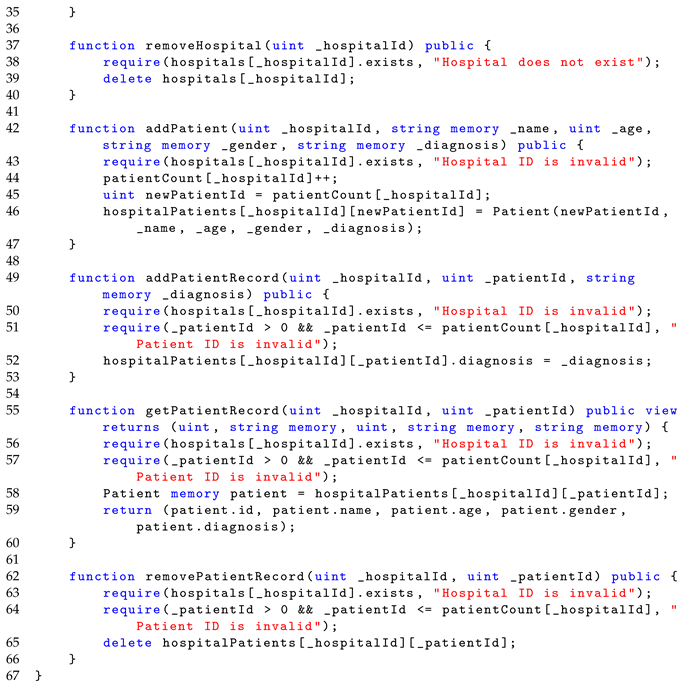 |
References
- Adlam, R.; Haskins, B. Applying Blockchain Technology to Security-Related Aspects of Electronic Healthcare Record Infrastructure. Afr. J. Inf. Commun. 2021, 28, 1–28. [Google Scholar] [CrossRef]
- Häyrinen, K.; Saranto, K.; Nykänen, P. Definition, structure, content, use and impacts of electronic health records: A review of the research literature. Int. J. Med. Inform. 2023, 46, 165–179. [Google Scholar] [CrossRef] [PubMed]
- Shortliffe, E.H. The evolution of electronic medical records. Acad. Med. 1999, 74, 414–419. [Google Scholar] [CrossRef] [PubMed]
- Khan, F.A.; Muazzam, A.K.; Suliman, A.A.; Walid, E.; Mujeeb, U.R.; Jawad, A. An Immutable Framework for Smart Healthcare Using Blockchain Technology. Comput. Syst. Sci. Eng. 1999, 74, 414–419. [Google Scholar]
- Yu, T.; Sekar, V.; Seshan, S.; Agarwal, Y.; Xu, C. Handling a trillion (unfixable) flaws on a billion devices: Rethinking network security for the internet-of-things. In Proceedings of the 14th ACM Workshop on Hot Topics in Networks, Philadelphia, PA, USA, 16–17 November 2015; pp. 1–7. [Google Scholar]
- Wang, S.; Yuan, Y.; Wang, X.; Li, J.; Qin, R.; Wang, F.Y. An overview of smart contract: Architecture, applications, and future trends. In Proceedings of the 2018 IEEE Intelligent Vehicles Symposium (IV), Suzhou, China, 26–30 June 2018; pp. 108–113. [Google Scholar]
- Li, J.; Wu, J.; Chen, L. Block-secure: Blockchain based scheme for secure P2P cloud storage. Inf. Sci. 2018, 465, 219–231. [Google Scholar] [CrossRef]
- Zhang, S.; Lee, J.H. Analysis of the main consensus protocols of blockchain. ICT Express 2020, 6, 93–97. [Google Scholar] [CrossRef]
- Shahnaz, A.; Qamar, U.; Khalid, A. Using blockchain for electronic health records. IEEE Access 2019, 7, 147782–147795. [Google Scholar] [CrossRef]
- Bell, K.M. HHS National Alliance for Health Information Technology (NAHIT); Report to the Officer of the National Coordinator for Health Information Technology on Defining Key Health Information Technology Terms: DC, USA, 2008; pp. 1–40. Available online: http://tigerstandards.pbworks.com/f/HITTermsFinalReport.pdf (accessed on 9 September 2024).
- Golosova, J.; Romanovs, A. The advantages and disadvantages of the blockchain technology. In Proceedings of the 2018 IEEE 6th Workshop on Advances in Information, Electronic and Electrical Engineering (AIEEE), Vilnius, Lithuania, 8–10 November 2018; pp. 1–6. [Google Scholar]
- Al-Breiki, H.; Rehman, M.H.U.; Salah, K.; Svetinovic, D. Trustworthy blockchain oracles: Review, comparison, and open research challenges. IEEE Access 2020, 8, 85675–85685. [Google Scholar] [CrossRef]
- Ahram, T.; Sargolzaei, A.; Sargolzaei, S.; Daniels, J.; Amaba, B. Blockchain technology innovations. In Proceedings of the 2017 IEEE Technology & Engineering Management Conference (TEMSCON), Evanston, IL, USA, 28 June–1 July 2017; pp. 137–141. [Google Scholar]
- Breidenbach, L.; Cachin, C.; Chan, B.; Coventry, A.; Ellis, S.; Juels, A.; Koushanfar, F.; Miller, A.; Magauran, B.; Moroz, D.; et al. Chainlink 2.0: Next steps in the evolution of decentralized oracle networks. Chainlink Labs 2021. Available online: https://research.chain.link/whitepaper-v2.pdf (accessed on 9 September 2024).
- Hepp, T.; Sharinghousen, M.; Ehret, P.; Schoenhals, A.; Gipp, B. On-chain vs. off-chain storage for supply-and blockchain integration. it-Inf. Technol. 2018, 60, 283–291. [Google Scholar] [CrossRef]
- Hillestad, R.; Bigelow, J.; Bower, A.; Girosi, F.; Meili, R.; Scoville, R.; Taylor, R. Can electronic medical record systems transform health care? Potential health benefits, savings, and costs. Health Aff. 2005, 24, 1103–1117. [Google Scholar] [CrossRef] [PubMed]
- Watanabe, H.; Fujimura, S.; Nakadaira, A.; Miyazaki, Y.; Akutsu, A.; Kishigami, J. Blockchain contract: Securing a blockchain applied to smart contracts. In Proceedings of the 2016 IEEE International Conference on Consumer Electronics (ICCE), Las Vegas, NV, USA, 7–11 January 2016; pp. 467–468. [Google Scholar]
- Zheng, Z.; Xie, S.; Dai, H.N.; Chen, W.; Chen, X.; Weng, J.; Imran, M. An overview on smart contracts: Challenges, advances and platforms. Future Gener. Comput. Syst. 2020, 105, 475–491. [Google Scholar] [CrossRef]
- Hewa, T.; Ylianttila, M.; Liyanage, M. Survey on blockchain based smart contracts: Applications, opportunities and challenges. J. Netw. Comput. Appl. 2021, 177, 102857. [Google Scholar] [CrossRef]
- Wang, S.; Ouyang, L.; Yuan, Y.; Ni, X.; Han, X.; Wang, F.Y. Blockchain-enabled smart contracts: Architecture, applications, and future trends. IEEE Trans. Syst. Man Cybern. Syst. 2019, 49, 2266–2277. [Google Scholar] [CrossRef]
- Cheikhrouhou, O.; Mershad, K.; Jamil, F.; Mahmud, R.; Koubaa, A.; Moosavi, S.R. A lightweight blockchain and fog-enabled secure remote patient monitoring system. Internet Things 2023, 22, 100691. [Google Scholar] [CrossRef]
- Kumar, R.; Marchang, N.; Tripathi, R. Distributed off-chain storage of patient diagnostic reports in healthcare system using IPFS and blockchain. In Proceedings of the 2020 IEEE International Conference on Communication Systems & Networks (COMSNETS), Bengaluru, India, 7–11 January 2020; pp. 1–5. [Google Scholar]
- Fernando, E.; Cassandra, C. Medicine Information Record Based on Blockchain Technology. In Proceedings of the 2021 2nd IEEE International Conference on Innovative and Creative Information Technology (ICITech), Virtual, 23–25 September 2021; pp. 169–173. [Google Scholar]
- Ante, L. Smart contracts on the blockchain–A bibliometric analysis and review. Telemat. Inform. 2021, 57, 101519. [Google Scholar] [CrossRef]
- Ashfaq, T.; Khalid, M.I.; Ali, G.; Affendi, M.E.; Iqbal, J.; Hussain, S.; Ullah, S.S.; Yahaya, A.S.; Khalid, R.; Mateen, A. An efficient and secure energy trading approach with machine learning technique and consortium blockchain. Sensors 2022, 22, 7263. [Google Scholar] [CrossRef]
- Hadi, H.J.; Hayat, U.; Musthaq, N.; Hussain, F.B.; Cao, Y. Developing Realistic Distributed Denial of Service (DDoS) Dataset for Machine Learning-based Intrusion Detection System. In Proceedings of the 2022 9th IEEE International Conference on Internet of Things: Systems, Management and Security (IOTSMS), Milan, Italy, 29 November–1 December 2022; pp. 1–6. [Google Scholar]
- Hadi, H.J.; Cao, Y.; Li, S.; Xu, L.; Hu, Y.; Li, M. Real-time fusion multi-tier DNN-based collaborative IDPS with complementary features for secure UAV-enabled 6G networks. Expert Syst. Appl. 2024, 252, 124215. [Google Scholar] [CrossRef]
- Ali, G.; Ahmad, N.; Cao, Y.; Ali, Q.E.; Azim, F.; Cruickshank, H. BCON: Blockchain based access CONtrol across multiple conflict of interest domains. J. Netw. Comput. Appl. 2019, 147, 102440. [Google Scholar] [CrossRef]
- Sammeta, N.; Parthiban, L. Data Ownership and Secure Medical Data Transmission using Optimal Multiple Key-Based Homomorphic Encryption with Hyperledger Blockchain. Int. J. Image Graph. 2021, 23, 2240003. [Google Scholar] [CrossRef]
- Saba, T.; Haseeb, K.; Rehman, A.; Jeon, G. Blockchain-Enabled Intelligent IoT Protocol for High-Performance and Secured Big Financial Data Transaction. IEEE Trans. Comput. Soc. Syst. 2024, 11, 1667–1674. [Google Scholar] [CrossRef]
- Fatima, N.; Agarwal, P.; Sohail, S.S. Security and privacy issues of blockchain technology in health care—A review. ICT Anal. Appl. 2022, 314, 193–201. [Google Scholar]
- Babar, M.; Qureshi, B.; Koubaa, A. Investigating the impact of data heterogeneity on the performance of federated learning algorithm using medical imaging. PLoS ONE 2024, 19, e0302539. [Google Scholar] [CrossRef] [PubMed]
- Butt, A.U.R.; Mahmood, T.; Saba, T.; Bahaj, S.A.O.; Alamri, F.S.; Iqbal, M.W.; Khan, A.R. An Optimized Role-Based Access Control Using Trust Mechanism in E-Health Cloud Environment. IEEE Access 2023, 11, 138813–138826. [Google Scholar] [CrossRef]
- Khan, I.; Qazi, E.A.; Hadi, H.J.; Ahmad, N.; Ali, G.; Cao, Y.; Alshara, M.A. Securing Blockchain-Based Supply Chain Management: Textual Data Encryption and Access Control. Technologies 2024, 12, 110. [Google Scholar] [CrossRef]
- Mohanta, B.K.; Panda, S.S.; Jena, D. An overview of smart contract and use cases in blockchain technology. In Proceedings of the 2018 9th IEEE International Conference on Computing, Communication and Networking Technologies (ICCCNT), Bengaluru, India, 10–12 July 2018; pp. 1–4. [Google Scholar]
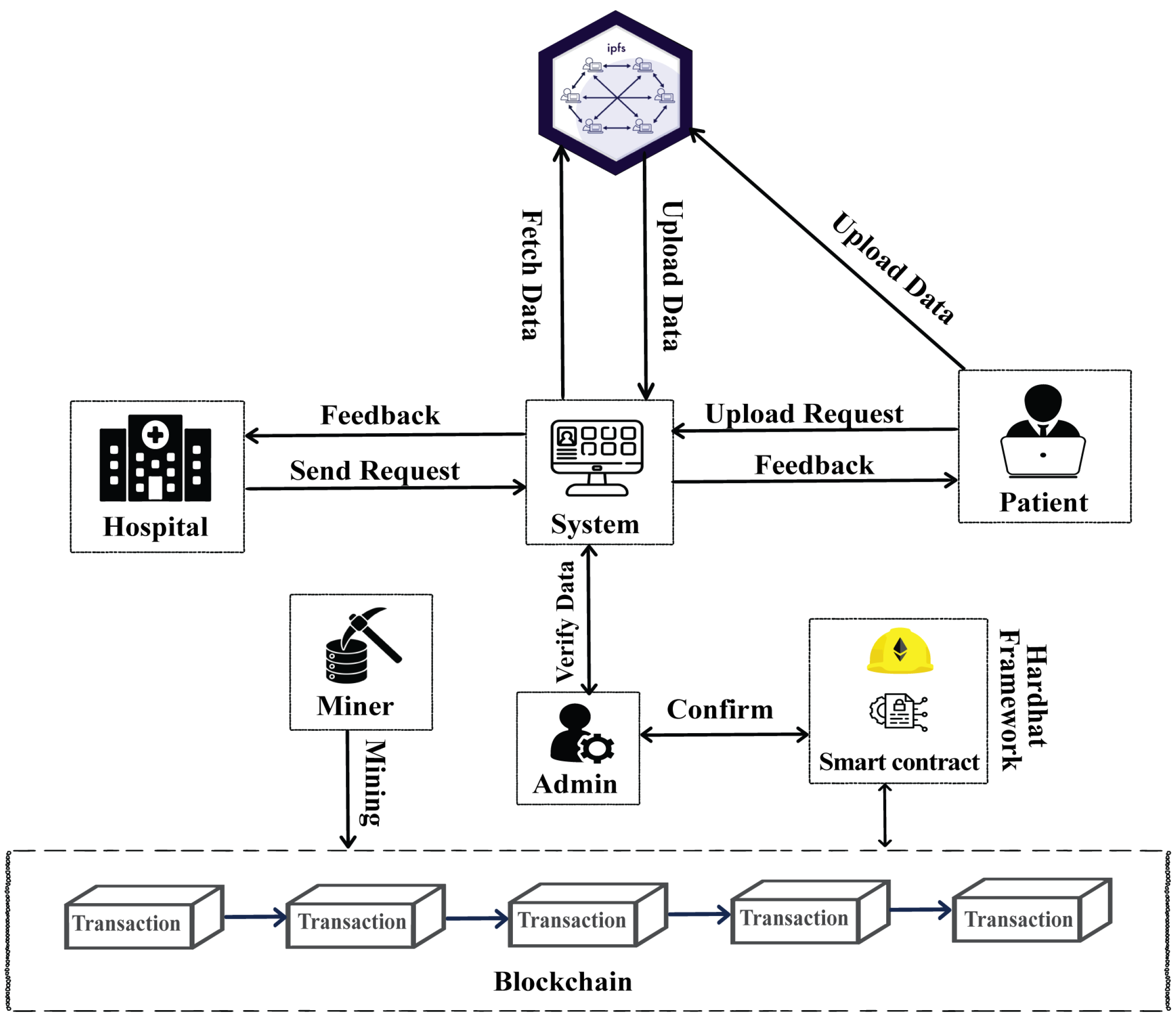
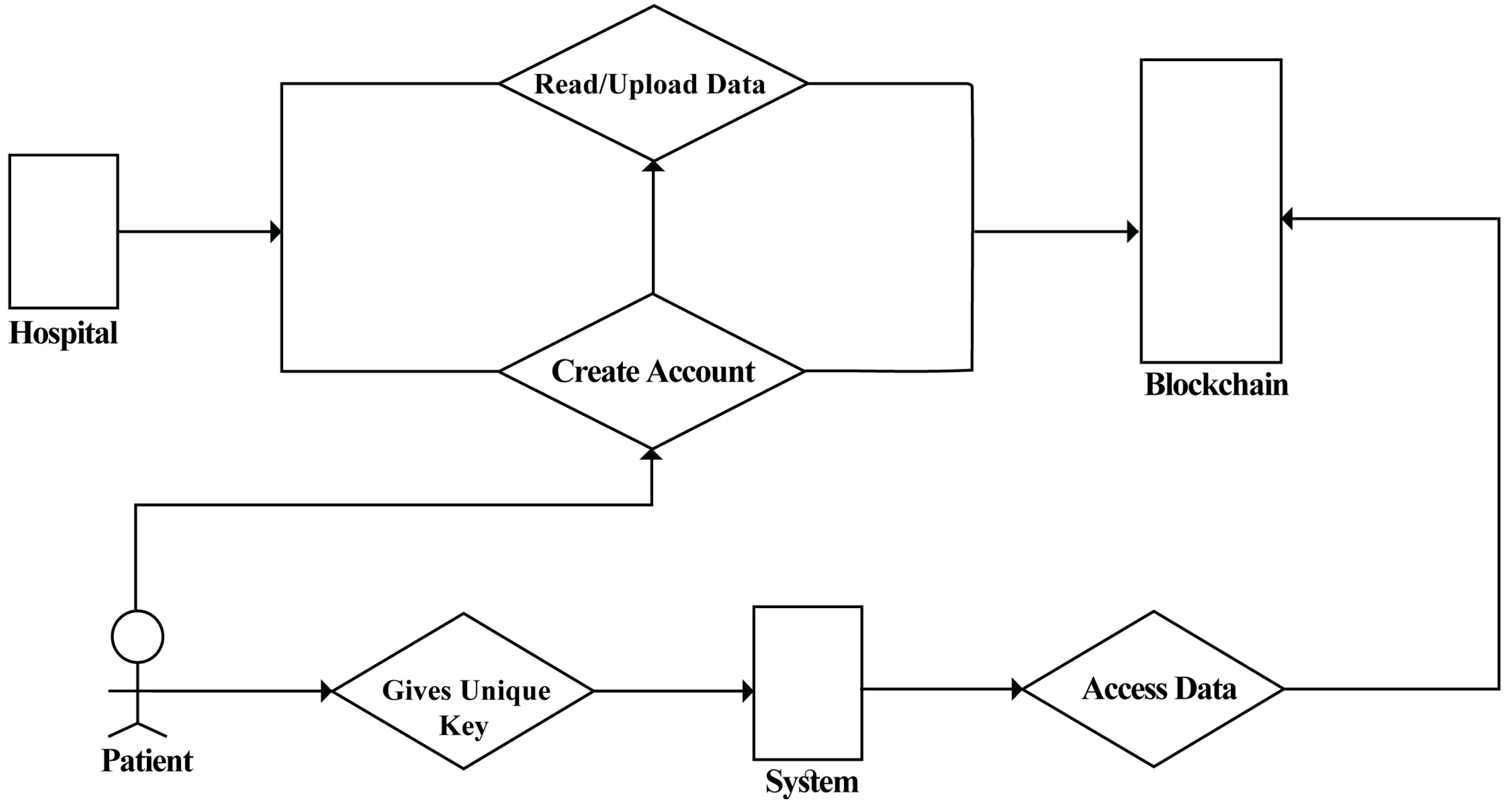
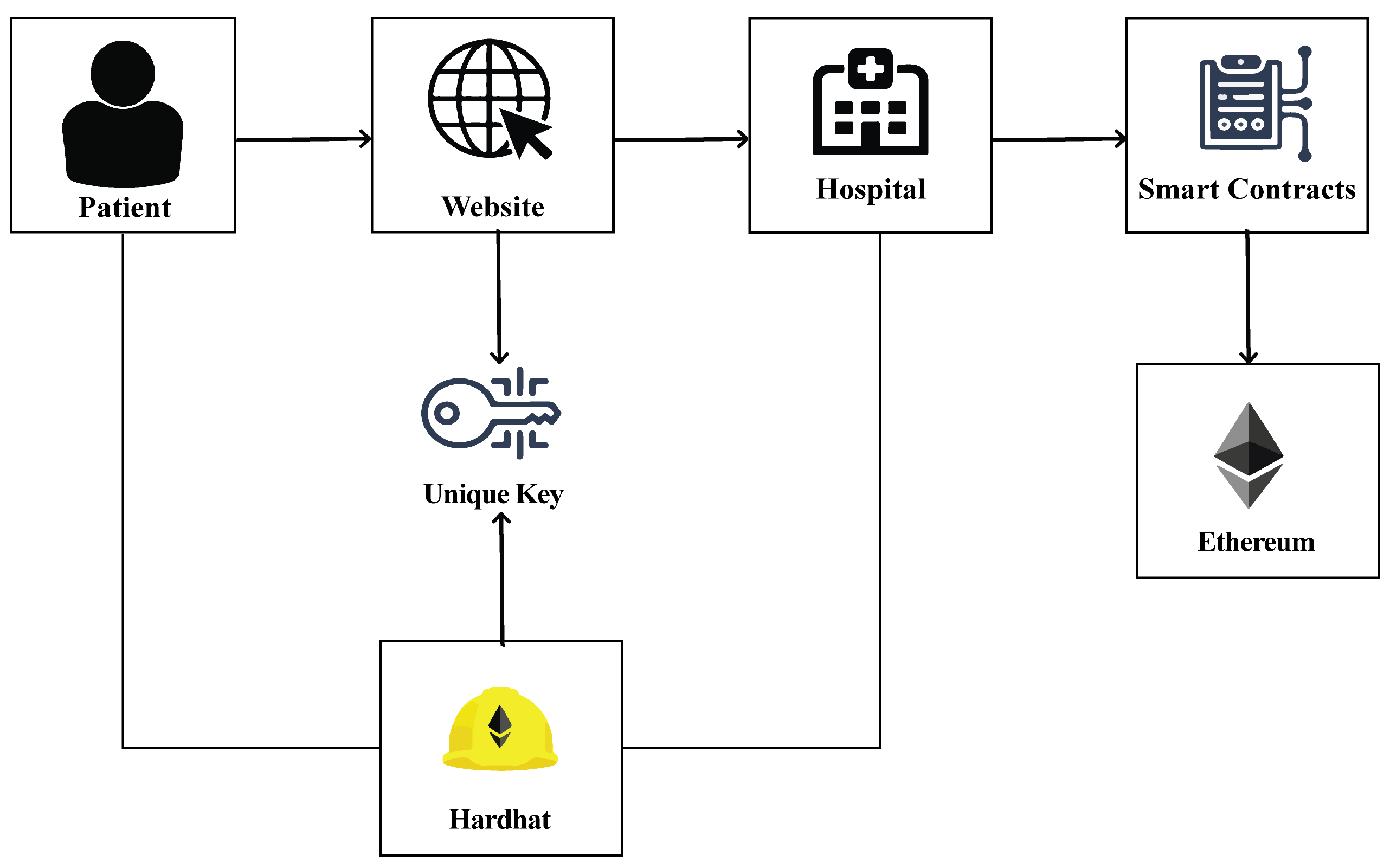
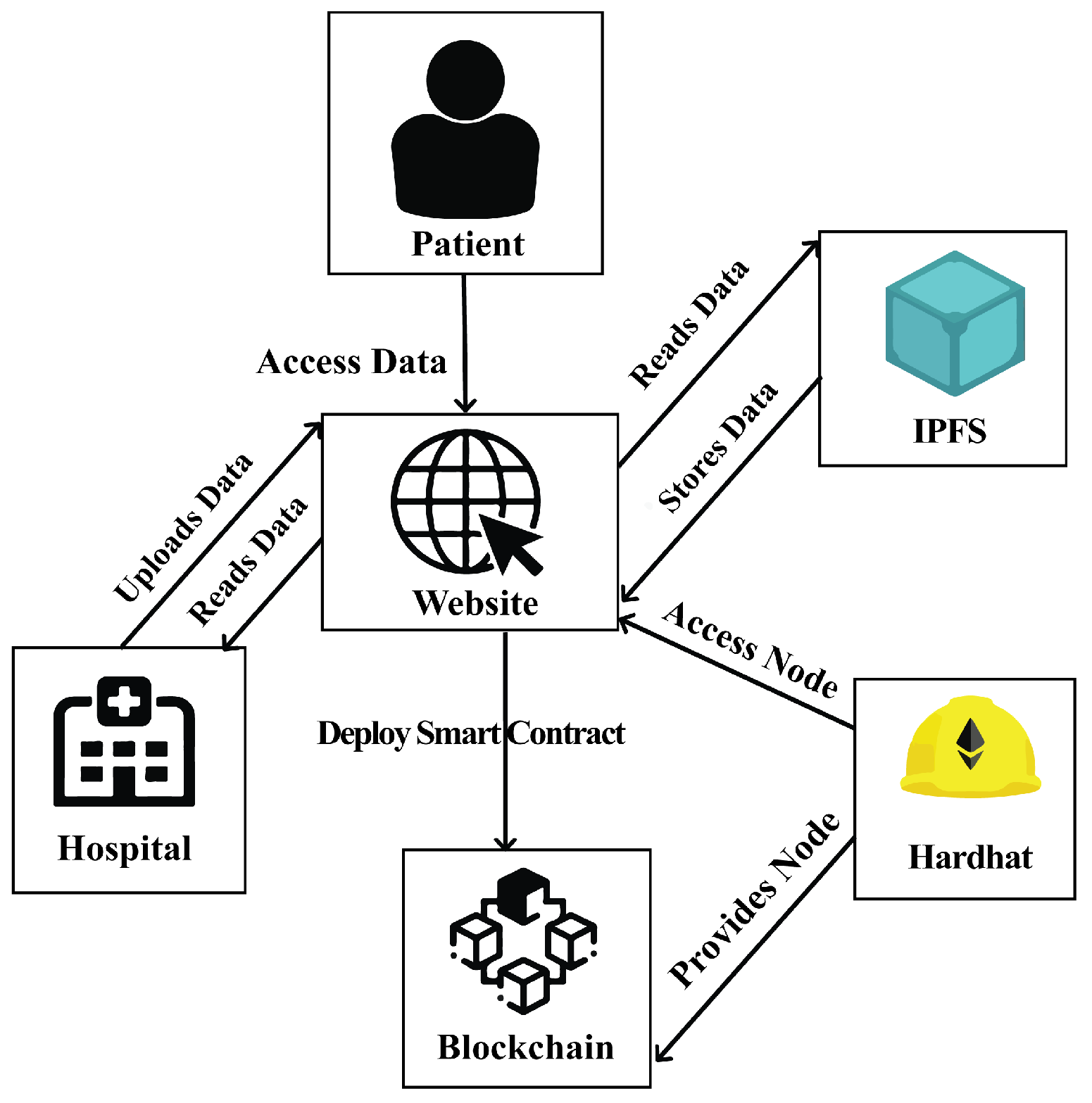
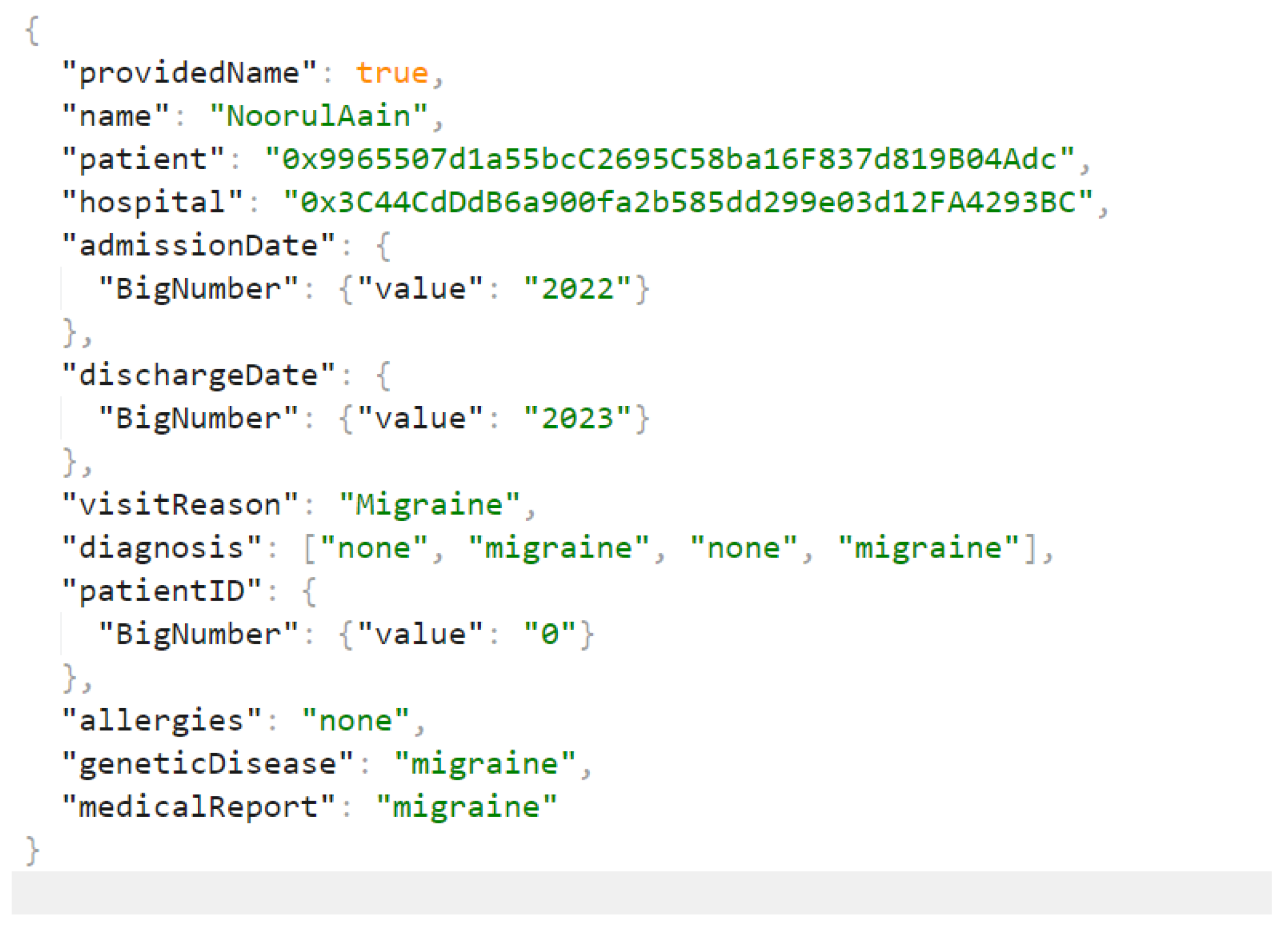
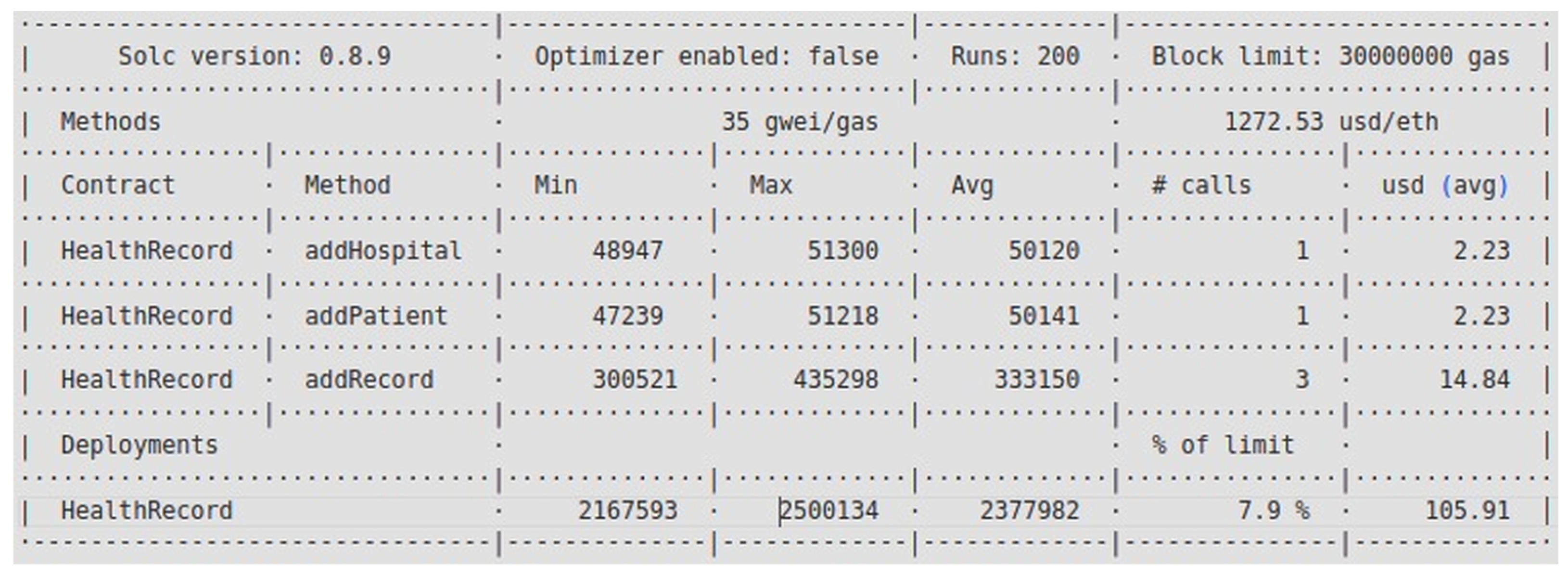



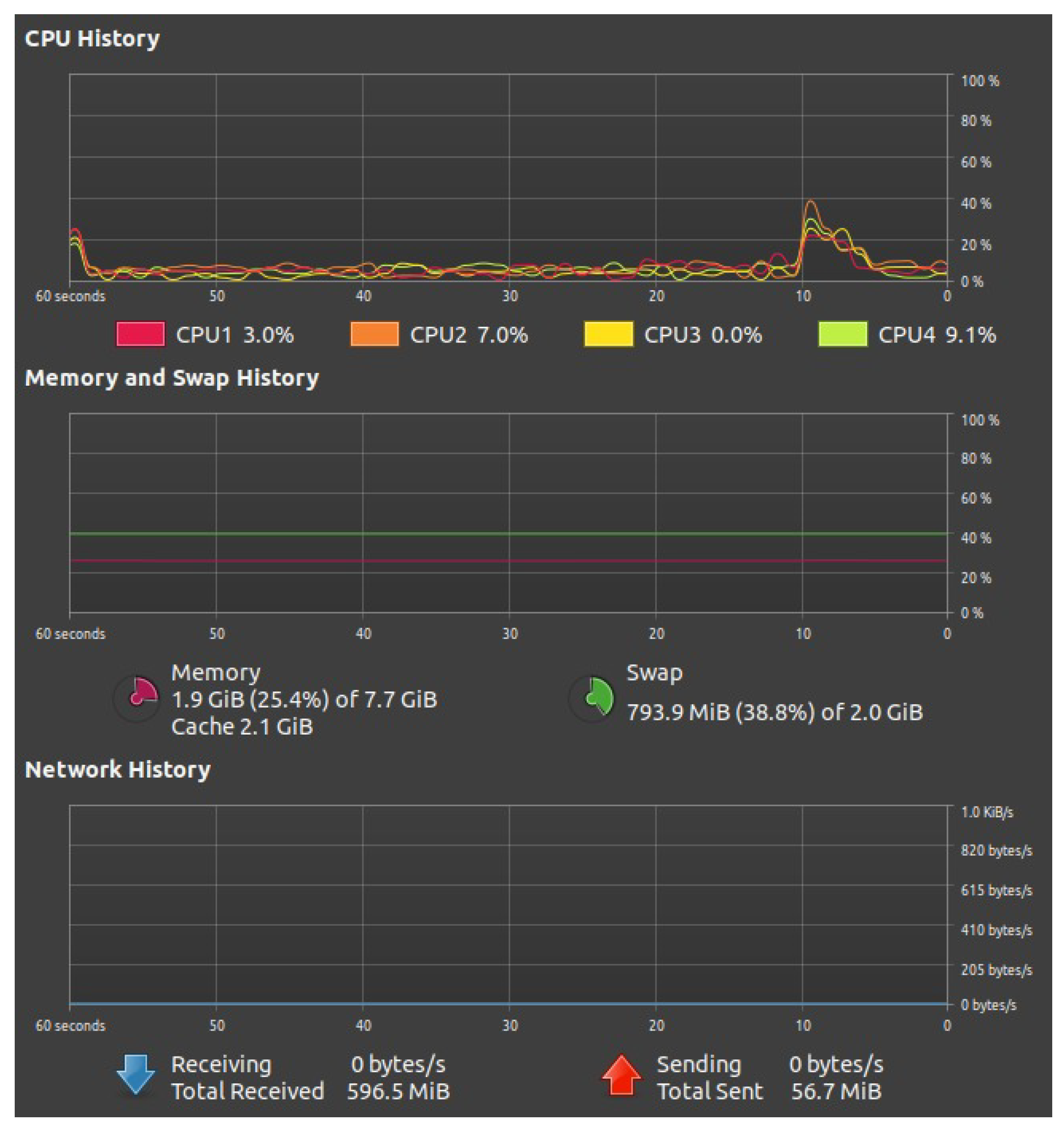
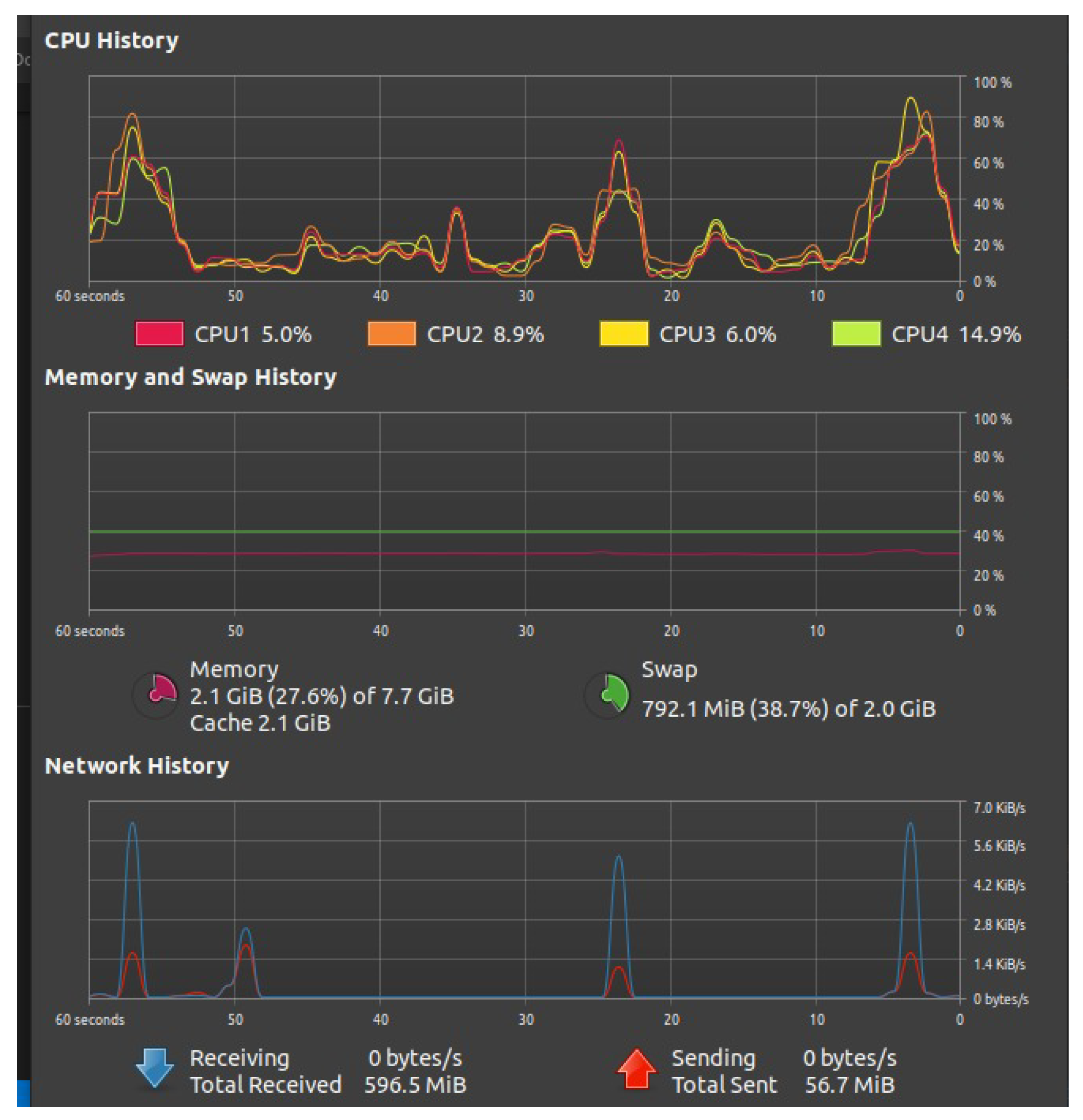

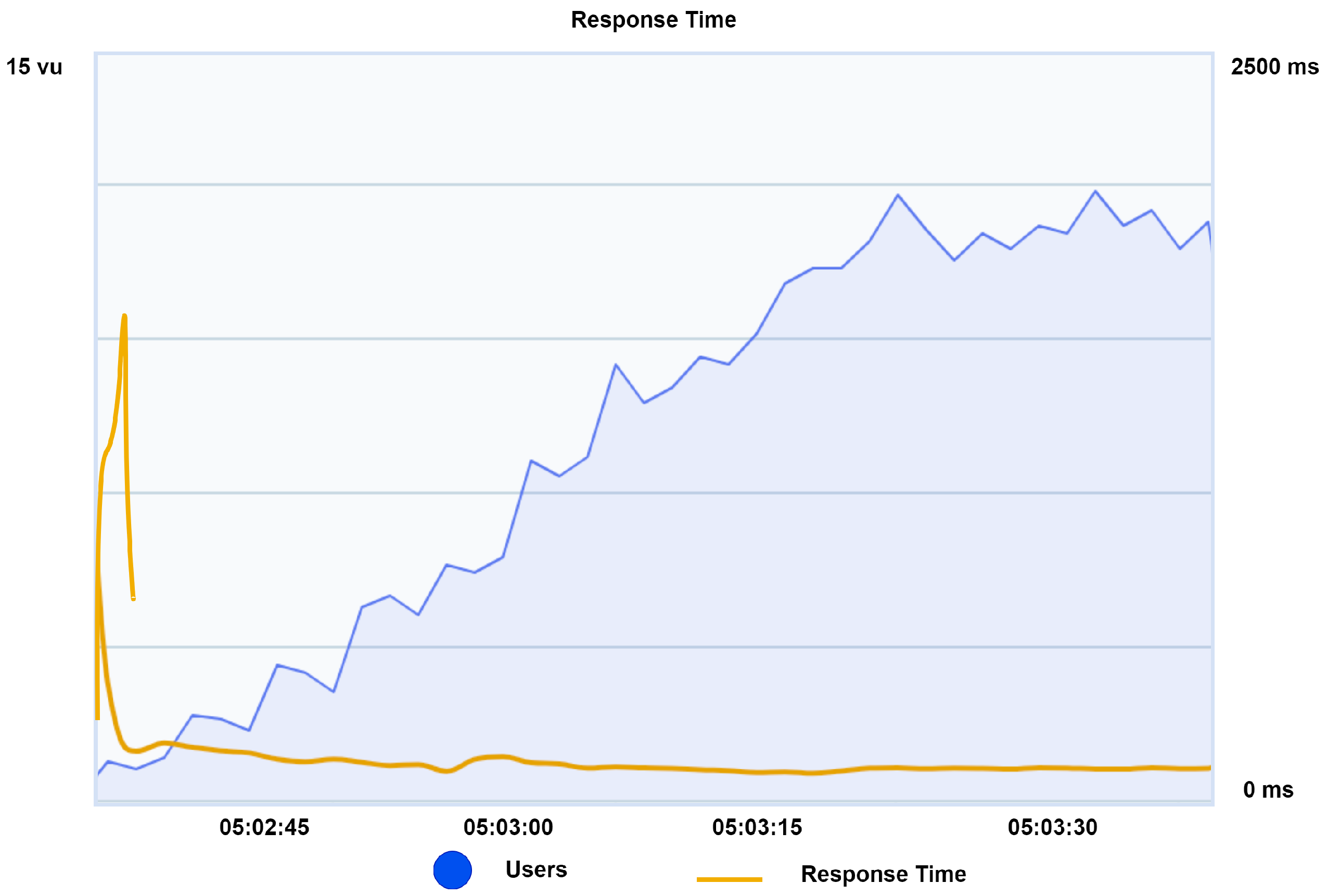
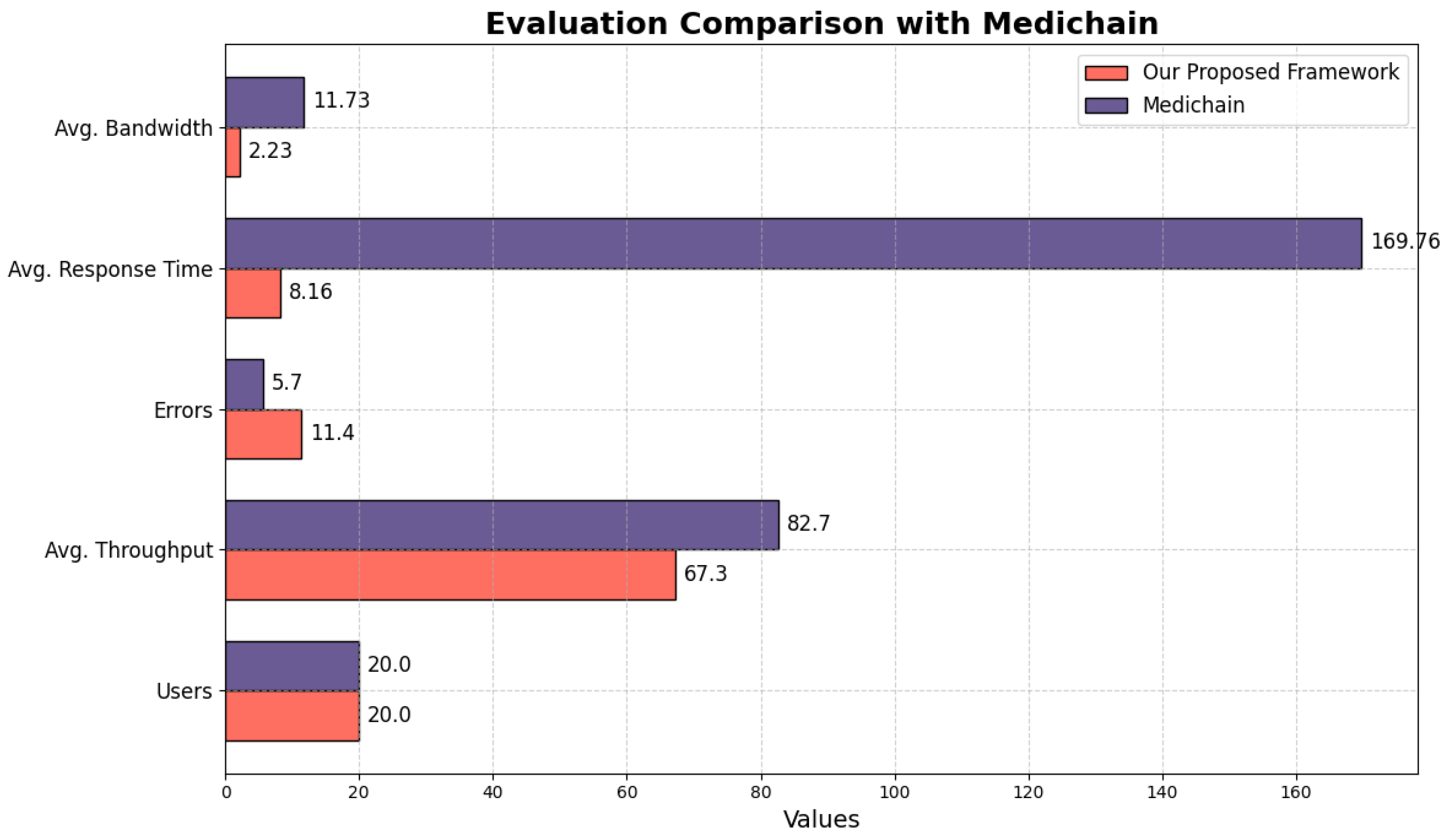
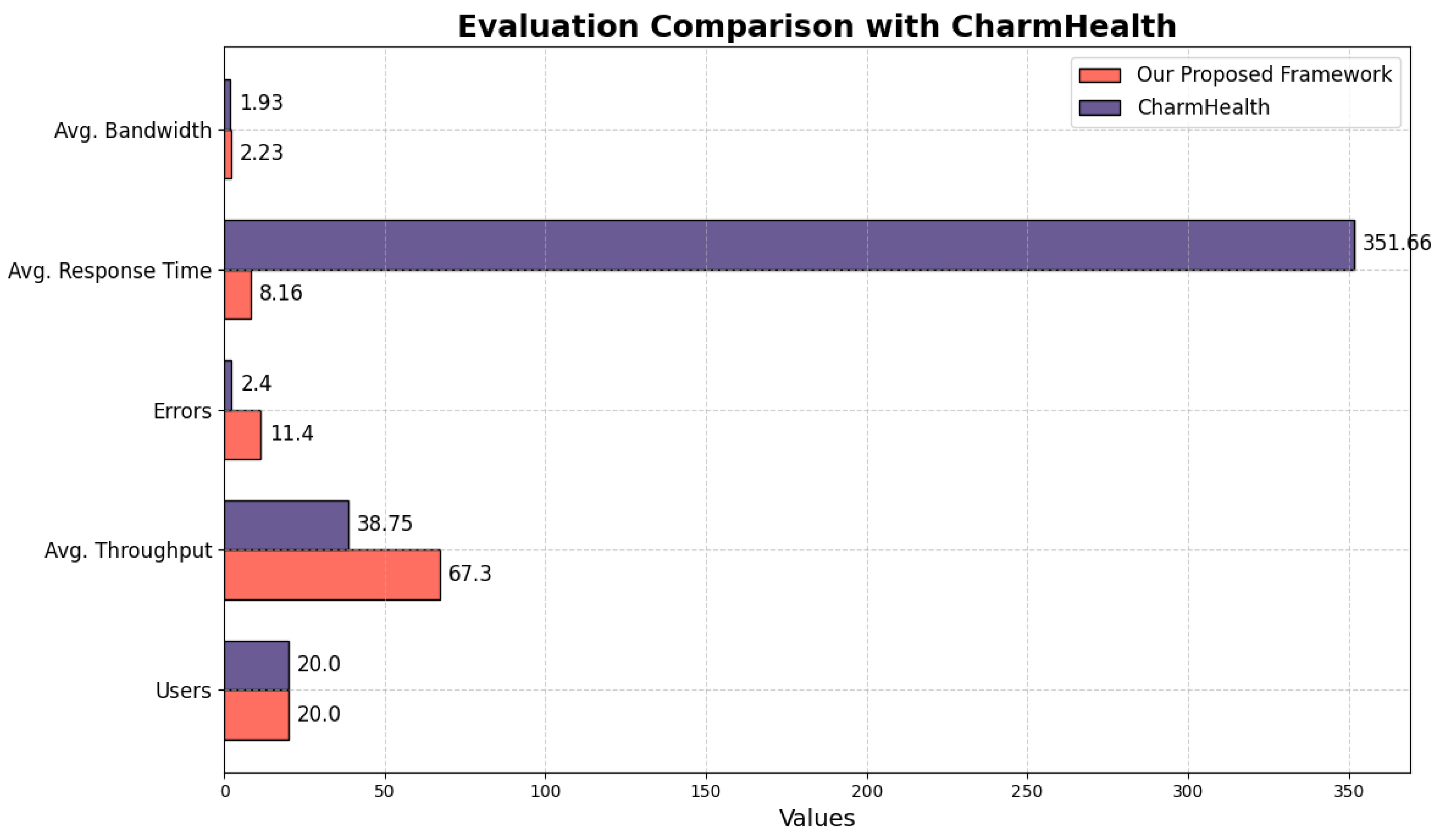
| Variable Name | Type | Scope | Description |
|---|---|---|---|
| id | uint | Hospital/Patient | Unique identifier for the hospital or patient |
| name | string | Hospital/Patient | Name of the hospital or patient |
| location | string | Hospital | Location of the hospital |
| phone | string | Hospital | Contact phone number of the hospital |
| string | Hospital | Contact email address of the hospital | |
| age | uint | Patient | Age of the patient |
| gender | string | Patient | Gender of the patient |
| diagnosis | string | Patient | Diagnosis of the patient |
| exists | bool | Hospital | Flag to indicate if the hospital exists |
| hospitals | mapping(uint => Hospital) | HospitalRegistry | Mapping of hospital ID to hospital details |
| hospitalPatients | mapping(uint => mapping(uint => Patient)) | HospitalRegistry | Mapping of hospital ID to patient details |
| patientCount | mapping(uint => uint) | HospitalRegistry | Counter to keep track of the number of patients per hospital |
| hospitalCount | uint | HospitalRegistry | Counter to keep track of the number of hospitals added |
| Function | Transaction Cost (Ether) | Cost (USD) |
|---|---|---|
| addHospital | 0.000204696 Ether | $0.705 |
| removeHospital | 0.000103356 Ether | $0.356 |
| addPatient | 0.000183084 Ether | $0.631 |
| addPatientRecord | 0.000122658 Ether | $0.423 |
| getPatientRecord | 0.000061788 Ether | $0.213 |
| removePatientRecord | 0.000084224 Ether | $0.290 |
Disclaimer/Publisher’s Note: The statements, opinions and data contained in all publications are solely those of the individual author(s) and contributor(s) and not of MDPI and/or the editor(s). MDPI and/or the editor(s) disclaim responsibility for any injury to people or property resulting from any ideas, methods, instructions or products referred to in the content. |
© 2024 by the authors. Licensee MDPI, Basel, Switzerland. This article is an open access article distributed under the terms and conditions of the Creative Commons Attribution (CC BY) license (https://creativecommons.org/licenses/by/4.0/).
Share and Cite
Tahir, N.U.A.; Rashid, U.; Hadi, H.J.; Ahmad, N.; Cao, Y.; Alshara, M.A.; Javed, Y. Blockchain-Based Healthcare Records Management Framework: Enhancing Security, Privacy, and Interoperability. Technologies 2024, 12, 168. https://doi.org/10.3390/technologies12090168
Tahir NUA, Rashid U, Hadi HJ, Ahmad N, Cao Y, Alshara MA, Javed Y. Blockchain-Based Healthcare Records Management Framework: Enhancing Security, Privacy, and Interoperability. Technologies. 2024; 12(9):168. https://doi.org/10.3390/technologies12090168
Chicago/Turabian StyleTahir, Noor Ul Ain, Umer Rashid, Hassan Jalil Hadi, Naveed Ahmad, Yue Cao, Mohammed Ali Alshara, and Yasir Javed. 2024. "Blockchain-Based Healthcare Records Management Framework: Enhancing Security, Privacy, and Interoperability" Technologies 12, no. 9: 168. https://doi.org/10.3390/technologies12090168
APA StyleTahir, N. U. A., Rashid, U., Hadi, H. J., Ahmad, N., Cao, Y., Alshara, M. A., & Javed, Y. (2024). Blockchain-Based Healthcare Records Management Framework: Enhancing Security, Privacy, and Interoperability. Technologies, 12(9), 168. https://doi.org/10.3390/technologies12090168








